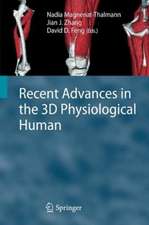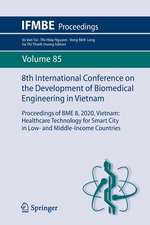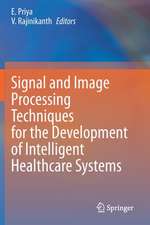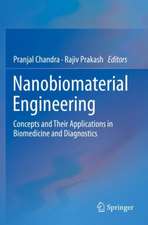Biomedical Information Technology: Biomedical Engineering
Editat de David Dagan Fengen Limba Engleză Hardback – 4 oct 2007
All biomedical professionals can benefit from a greater understanding of how data can be efficiently managed and utilized through data compression, modelling, processing, registration, visualization, communication, and large-scale biological computing. In addition Biomedical Information Technology contains practical integrated clinical applications for disease detection, diagnosis, surgery, therapy, and biomedical knowledge discovery, including the latest advances in the field, such as ubiquitous M-Health systems and molecular imaging applications.
- The world's most recognized authorities give their "best practices" ready for implementation
- Provides professionals with the most up to date and mission critical tools to evaluate the latest advances in the field and current integrated clinical applications
- Gives new staff the technological fundamentals and updates experienced professionals with the latest practical integrated clinical applications
| Toate formatele și edițiile | Preț | Express |
|---|---|---|
| Paperback (1) | 872.89 lei 5-7 săpt. | |
| ELSEVIER SCIENCE – 17 oct 2019 | 872.89 lei 5-7 săpt. | |
| Hardback (1) | 629.79 lei 5-7 săpt. | |
| ELSEVIER SCIENCE – 4 oct 2007 | 629.79 lei 5-7 săpt. |
Din seria Biomedical Engineering
- 22%
 Preț: 450.88 lei
Preț: 450.88 lei - 35%
 Preț: 557.07 lei
Preț: 557.07 lei - 23%
 Preț: 794.10 lei
Preț: 794.10 lei - 5%
 Preț: 808.68 lei
Preț: 808.68 lei - 23%
 Preț: 549.27 lei
Preț: 549.27 lei - 22%
 Preț: 605.36 lei
Preț: 605.36 lei - 29%
 Preț: 868.53 lei
Preț: 868.53 lei - 8%
 Preț: 423.60 lei
Preț: 423.60 lei - 30%
 Preț: 782.99 lei
Preț: 782.99 lei - 25%
 Preț: 690.65 lei
Preț: 690.65 lei - 21%
 Preț: 339.72 lei
Preț: 339.72 lei - 5%
 Preț: 1160.03 lei
Preț: 1160.03 lei -
 Preț: 379.23 lei
Preț: 379.23 lei - 23%
 Preț: 619.56 lei
Preț: 619.56 lei -
 Preț: 447.05 lei
Preț: 447.05 lei - 18%
 Preț: 560.53 lei
Preț: 560.53 lei - 18%
 Preț: 953.44 lei
Preț: 953.44 lei - 18%
 Preț: 966.34 lei
Preț: 966.34 lei - 18%
 Preț: 1292.62 lei
Preț: 1292.62 lei - 15%
 Preț: 585.30 lei
Preț: 585.30 lei - 26%
 Preț: 1161.10 lei
Preț: 1161.10 lei -

Preț: 629.79 lei
Preț vechi: 704.87 lei
-11% Nou
Puncte Express: 945
Preț estimativ în valută:
120.51€ • 125.82$ • 99.74£
120.51€ • 125.82$ • 99.74£
Carte tipărită la comandă
Livrare economică 29 martie-12 aprilie
Preluare comenzi: 021 569.72.76
Specificații
ISBN-13: 9780123735836
ISBN-10: 0123735831
Pagini: 552
Ilustrații: Approx. 410 illustrations
Dimensiuni: 216 x 276 x 25 mm
Greutate: 1.45 kg
Editura: ELSEVIER SCIENCE
Seria Biomedical Engineering
ISBN-10: 0123735831
Pagini: 552
Ilustrații: Approx. 410 illustrations
Dimensiuni: 216 x 276 x 25 mm
Greutate: 1.45 kg
Editura: ELSEVIER SCIENCE
Seria Biomedical Engineering
Public țintă
biomedical and clinical engineers; physicians and surgeons; health physicists; bioinformaticists; biomedical researchers, students, educators; members of the basic science community; IT specialists, healthcare professionals and researchers.Cuprins
Section I:Technological Fundamentals
Chapter 1Medical Imaging
Dr. Xiaofeng Zhang, Dr. Nadine Smith and Prof. Andrew Webb
1.1Introduction
1.2Digital radiography
1.3Computed tomography
1.4Nuclear medicine
1.5Ultrasonic imaging
1.6Magnetic resonance imaging
1.7Diffuse optical imaging
1.8Biosignals
1.9Appendix
1.10Exercises
1.11Bibliography
1.12Index
Chapter 2Electronic Medical Record (EMR)
Dr. Eugene,Y. S. Lim, Prof. Michael Fulham and Prof. David Dagan Feng
2.1Introduction
2.2Medical data and patient record
2.3Terminology standards – vocabulary and a clinical coding system1
2.4Information exchange standards
2.5Usability issues in EMR
2.6User interface
2.7Evaluation
2.8EMR system – a case study: a web-based imaging electronic patient history
2.9Summary
2.10Exercise
2.11Bibliography and references
2.12Index
Chapter 3Image Data Compression and Storage
Prof. Hong Ren Wu, Dr. Damian M. Tan, Dr. Tom Weidong Cai and Prof. David Dagan Feng
3.1Introduction
3.2Picture compression
3.3Compression in the dicom standard
3.4Data compression for dynamic functional images
3.5Summary
3.6Exercises
3.7References
3.8Index
Chapter 4Content-Based Medical Image Retrieval
Dr. Tom Weidong Cai, Dr. Jinman Kim and Prof. David Dagan Feng
4.1Introduction
4.2CBMIR by physical visual features
4.3CBMIR by geometric spatial features
4.4CBMIR by combination of semantic and visual features
4.5CBMIR by physiological functional features
4.6Summary
4.7Exercises
4.8Bibliography and references
4.9Index
Chapter 5Data Modeling and Simulation
Dr. Alessandra Bertoldo, Prof. Claudio Cobelli
5.1Introduction
5.2Compartmental models
5.3Model identification
5.4Model validation
5.5Simulation
5.6Case study
5.7Quantification of medical images
5.8Exercises
5.9Bibliography and references
Chapter 6Techniques for Parametric Imaging
Prof. David Dagan Feng, Dr. Lingfeng Wen and Dr. Stefan Eberl
6.1Introduction
6.2Parametric image estimation methods
6.3Noninvasive methods
6.4Clinical applications of parametric images
6.5Summary
6.6Exercise
6.7Bibliography and references
6.8Index
Chapter 7Data Processing and Analysis
Prof. Chris Wyatt, Prof. Yu-Ping Wang, Prof. Matthew T. Freedman, Prof. Murray Loew and Prof. Yue Wang
7.1Introduction
7.2Medical image enhancement
7.3Medical image segmentation
7.4Medical image feature extraction
7.5Medical image interpretation
7.6Summary
7.7Exercises
7.8Bibliography
7.9Index
Chapter 8Data Registration and Fusion
Dr. Xiu Ying Wang, Dr. Stefan Eberl, Prof. Michael Fulham, Dr. Seu Som and Prof. David Dagan Feng
8.1Introduction
8.2Fundamentals of biomedical image registration and fusion
8.3Feature-based medical image registration
8.4Intensity-based registration
8.5Hybrid registration and hierarchical registration
8.6Hardware registration
8.7Assessment of registration accuracy
8.8Applications of biomedical image registration and fusion
8.9Summary
8.10Exercises
8.11Bibliography and references
8.12Index
Chapter 9Data Visualization and Display
Dr. Jinman Kim, Dr. Tom Weidong Cai, Prof. Michael Fulham, Dr. Stefan Eberl and Prof. David Dagan Feng
9.1Introduction
9.2Two-Dimensional (2D) visualization techniques
9.3Three-Dimensional (3D) visualization techniques
9.4Volume navigation interface
9.5Volume enhancement and manipulation
9.6Large data visualization and optimization
9.7Dual-modality PET/CT visualization
9.8Data display devices
9.9Applications of biomedical visualization
9.10Summary
9.11Exercises
9.12Bibliography and references
9.13Index
Chapter 10Data Communication and Network Infrastructue
Prof. Doan B. Hoang and Dr. Andrew J. Simmonds
10.1Introduction
10.2Transmission and communication technologies
10.3The internet and World Wide Web
10.4Wireless and mobile technologies in m-health
10.5Sensor networks for health monitoring
10.6Applications of wireless technologies in telemedicine
10.7Summary
10.8Exercises
10.9Bibliography and references
10.10Index
Chapter 11Data Security and Protection for Medical Images
Dr. Eugene, Y. S. Lim
11.1Introduction
11.2Overview of cryptographic system
11.3Digital watermarking
11.4Medical image watermarking
11.5Region-based reversible watermarking for secure pet image management
11.6Summary
11.7 Exercise
11.8 Bibliography
11.8 Index
Chapter 12Biological Computing
Prof. Eric P Hoffman, Erica Reeves, Dr. Yetrib Hathout, Dr. Zuyi Wang and
Josephine Chen
12.1 Introduction
12.2 Overview of genomic methods
12.3 Overview of proteomic methods
12.4 Bioinformatics and information infrastructure
12.5 Data mining and large-scale biological databases
12.6 Biological event-driven, time-driven and hybrid simulation techniques
12.7 Summary
12.8 Bibliography
Section II: Integrated Applications
Chapter 13PACS and Medical Imaging Informatics (MII) for Filmless Hospitals
Prof. Brent J. Liu and Prof. H.K. Huang
13.1 Introduction
13.2 PACS infrastructure
13.3 PACS components and workflow
13.4 PACS controller and image archive
13.5 Large-scale PACS implementation
13.6 PACS clinical experiences
13.7 Summary
13.8 Exercises
13.9 Bibliography and references
13.9 Index
Chapter 14 KMeX: A Knowledge-Based Digital Library for Retrieving Scenario-Specific Medical Text Documents
Prof. Wesley W. Chu, Dr. Zhenyu Liu, Dr. Wenlei Mao and Dr. Qinghua Zou
14.1Introduction
14.2Extracting key concepts from documents
14.3Transforming similar queries into query templates
14.4Topic-oriented directory
14.5Phrase-based vector space model for automatic document retrieval
14.6Knowledge-based scenario-specific query expansion
14.7A system architecture for retrieving scenario-specific free text documents
14.8Summary
14.9Exercises
14.10Bibliography
Chapter 15Integrated Multimedia Patient Record Systems
Dr. Ruth E. Dayhoff, Mr. Peter M. Kuzmak and Mr. Kevin Meldrum
15.1 Introduction
15.2 Multimedia patient record
15.3 Multimedia patient record system architecture components
15.4 Electronic medical chart components
15.5 Objects comprising the multimedia patient record
15.6 Capturing multimedia data at the source
15.7 DICOM image acquisition
15.8 Remote data and image viewing across the healthcare network
15.9 Impact on patient care
15.10 Summary
15.11 References
Chapter 16Computer-Aided Diagnosis (CAD)
Prof. Maryellen L. Giger and Dr. Kenji Suzuki
16.1 Introduction
16.2 CAD
16.3 CAD for cancer screening
16.4 CAD for differential diagnosis
16.5 Intelligent CAD workstations – indices of similarity and human/computer interfaces
16.6 Summary
16.7 Exercises
16.8 Bibliography
16.9 Index
Chapter 17Clinical Decision Support Systems (CDSS)
Dr. Peter Weller, Dr. Abdul Roudsari and Prof. Ewart Carson
17.1 Introduction
17.2 Overview of CDSS
17.3 Human diagnostic reasoning
17.4 A structure for characterising CDSS
17.5 Decision support tools
17.6 Decision support systems in the hospital and other healthcare settings
17.7 Healthcare education applications
17.8 Verification, validation and evaluation
17.9 Summary
17.10 Exercises
17.11 References
17.12 Index
Chapter 18Medical Robotics and Computer-Integrated Interventional Medicine
Prof. Russell H. Taylor and Dr. Peter Kazanzides
18.1Introduction
18.2Technology & Techniques
18.3Surgical CAD/CAM
18.4Surgical Assistance
18.5Summary and conclusion
18.6Exercises
18.7References
18.8Index
Chapter 19 Functional Techniques for Brain Magnetic Resonance Imaging
Dr. Sirong Chen, Dr. Kai-Ming Au Yeung and Dr. Gladys Goh Lo
19.1Introduction
19.2Diffusion-weighted MR imaging in brain
19.3MR perfusion imaging in brain
19.4Functional MRI (fMRI) using bold techniques
19.5Clinical MR spectroscopy in brain
19.6Summary
19.7Exercises
19.8Bibliography and references
19.9Index
Chapter 20 Molecular Imaging in Cancer
Prof. Kristine Glunde, Dr. Catherine A. Foss and Prof. Zaver M. Bhujwalla
20.1Introduction
20.2Imaging of gene expression
20.3Receptor imaging
20.4Enzyme-activated probes
20.5Metabolic imaging
20.6Imaging of permeability, perfusion, and blood flow
20.7Imaging of the tumor microenvironment
20.8Multimodality imaging
20.9Conclusion
20.10Exercises
20.11References
20.12Index
Chapter 21Molecular Imaging in Biology and Pharmacology
Prof. Sung-Cheng Huang, Prof. Anna M. Wu and Prof. Jorge R. Barrio
21.1 Introduction and background
21.2 Considerations for quantitative molecular imaging
21.3 Design/development of molecular imaging probes
21.4 Molecular imaging of beta-amyloid and NFT
21.5 Molecular imaging using antibody probes
21.6 Some other molecular imaging applications
21.7 Summary and future perspectives
21.8 Exercises
21.9 References
21.10 Index
Chapter 22From Telemedicine to Ubiquitous M-Health: the Evolution of E Health Systems
Dr. Dejan Raškoviæ, Dr. Aleksandar Milenkoviæ, Prof. Piet C. De Groen and
Dr. Emil Jovanov
22.1Introduction
22.2Overview of m-health systems
22.3M-health based on Wireless Body Area Networks (WBAN)
22.4Wireless intelligent sensors for m-health
22.5Wireless mobile devices for m-health
22.6 Next-generation m-health systems
22.7 Summary
22.8 Exercises
22.9 References
22.10 Index
Chapter 23Multimedia for Future Health – Smart Medical Home………………1
Dr. Jinman Kim, Dr. Zhiyong Wang, Dr. Tom Weidong Cai and Prof. David Dagan Feng
23.1 Introduction
23.2 Multimedia for human-computer interaction
23.3 Multimedia content management
23.4 Multimedia delivery
23.5 Smart medical home
23.6 Telemedicine in the smart medical home
23.7 Sensory devices and health monitoring
23.8 Speech recognition and conversational systems
23.9 Multimedia technologies for patient education and care
23.10 Multimedia operating theater and Virtual Reality (VR)
23.11 Summary
23.12 Exercises
23.13 References
23.15 Index
Chapter 1Medical Imaging
Dr. Xiaofeng Zhang, Dr. Nadine Smith and Prof. Andrew Webb
1.1Introduction
1.2Digital radiography
1.3Computed tomography
1.4Nuclear medicine
1.5Ultrasonic imaging
1.6Magnetic resonance imaging
1.7Diffuse optical imaging
1.8Biosignals
1.9Appendix
1.10Exercises
1.11Bibliography
1.12Index
Chapter 2Electronic Medical Record (EMR)
Dr. Eugene,Y. S. Lim, Prof. Michael Fulham and Prof. David Dagan Feng
2.1Introduction
2.2Medical data and patient record
2.3Terminology standards – vocabulary and a clinical coding system1
2.4Information exchange standards
2.5Usability issues in EMR
2.6User interface
2.7Evaluation
2.8EMR system – a case study: a web-based imaging electronic patient history
2.9Summary
2.10Exercise
2.11Bibliography and references
2.12Index
Chapter 3Image Data Compression and Storage
Prof. Hong Ren Wu, Dr. Damian M. Tan, Dr. Tom Weidong Cai and Prof. David Dagan Feng
3.1Introduction
3.2Picture compression
3.3Compression in the dicom standard
3.4Data compression for dynamic functional images
3.5Summary
3.6Exercises
3.7References
3.8Index
Chapter 4Content-Based Medical Image Retrieval
Dr. Tom Weidong Cai, Dr. Jinman Kim and Prof. David Dagan Feng
4.1Introduction
4.2CBMIR by physical visual features
4.3CBMIR by geometric spatial features
4.4CBMIR by combination of semantic and visual features
4.5CBMIR by physiological functional features
4.6Summary
4.7Exercises
4.8Bibliography and references
4.9Index
Chapter 5Data Modeling and Simulation
Dr. Alessandra Bertoldo, Prof. Claudio Cobelli
5.1Introduction
5.2Compartmental models
5.3Model identification
5.4Model validation
5.5Simulation
5.6Case study
5.7Quantification of medical images
5.8Exercises
5.9Bibliography and references
Chapter 6Techniques for Parametric Imaging
Prof. David Dagan Feng, Dr. Lingfeng Wen and Dr. Stefan Eberl
6.1Introduction
6.2Parametric image estimation methods
6.3Noninvasive methods
6.4Clinical applications of parametric images
6.5Summary
6.6Exercise
6.7Bibliography and references
6.8Index
Chapter 7Data Processing and Analysis
Prof. Chris Wyatt, Prof. Yu-Ping Wang, Prof. Matthew T. Freedman, Prof. Murray Loew and Prof. Yue Wang
7.1Introduction
7.2Medical image enhancement
7.3Medical image segmentation
7.4Medical image feature extraction
7.5Medical image interpretation
7.6Summary
7.7Exercises
7.8Bibliography
7.9Index
Chapter 8Data Registration and Fusion
Dr. Xiu Ying Wang, Dr. Stefan Eberl, Prof. Michael Fulham, Dr. Seu Som and Prof. David Dagan Feng
8.1Introduction
8.2Fundamentals of biomedical image registration and fusion
8.3Feature-based medical image registration
8.4Intensity-based registration
8.5Hybrid registration and hierarchical registration
8.6Hardware registration
8.7Assessment of registration accuracy
8.8Applications of biomedical image registration and fusion
8.9Summary
8.10Exercises
8.11Bibliography and references
8.12Index
Chapter 9Data Visualization and Display
Dr. Jinman Kim, Dr. Tom Weidong Cai, Prof. Michael Fulham, Dr. Stefan Eberl and Prof. David Dagan Feng
9.1Introduction
9.2Two-Dimensional (2D) visualization techniques
9.3Three-Dimensional (3D) visualization techniques
9.4Volume navigation interface
9.5Volume enhancement and manipulation
9.6Large data visualization and optimization
9.7Dual-modality PET/CT visualization
9.8Data display devices
9.9Applications of biomedical visualization
9.10Summary
9.11Exercises
9.12Bibliography and references
9.13Index
Chapter 10Data Communication and Network Infrastructue
Prof. Doan B. Hoang and Dr. Andrew J. Simmonds
10.1Introduction
10.2Transmission and communication technologies
10.3The internet and World Wide Web
10.4Wireless and mobile technologies in m-health
10.5Sensor networks for health monitoring
10.6Applications of wireless technologies in telemedicine
10.7Summary
10.8Exercises
10.9Bibliography and references
10.10Index
Chapter 11Data Security and Protection for Medical Images
Dr. Eugene, Y. S. Lim
11.1Introduction
11.2Overview of cryptographic system
11.3Digital watermarking
11.4Medical image watermarking
11.5Region-based reversible watermarking for secure pet image management
11.6Summary
11.7 Exercise
11.8 Bibliography
11.8 Index
Chapter 12Biological Computing
Prof. Eric P Hoffman, Erica Reeves, Dr. Yetrib Hathout, Dr. Zuyi Wang and
Josephine Chen
12.1 Introduction
12.2 Overview of genomic methods
12.3 Overview of proteomic methods
12.4 Bioinformatics and information infrastructure
12.5 Data mining and large-scale biological databases
12.6 Biological event-driven, time-driven and hybrid simulation techniques
12.7 Summary
12.8 Bibliography
Section II: Integrated Applications
Chapter 13PACS and Medical Imaging Informatics (MII) for Filmless Hospitals
Prof. Brent J. Liu and Prof. H.K. Huang
13.1 Introduction
13.2 PACS infrastructure
13.3 PACS components and workflow
13.4 PACS controller and image archive
13.5 Large-scale PACS implementation
13.6 PACS clinical experiences
13.7 Summary
13.8 Exercises
13.9 Bibliography and references
13.9 Index
Chapter 14 KMeX: A Knowledge-Based Digital Library for Retrieving Scenario-Specific Medical Text Documents
Prof. Wesley W. Chu, Dr. Zhenyu Liu, Dr. Wenlei Mao and Dr. Qinghua Zou
14.1Introduction
14.2Extracting key concepts from documents
14.3Transforming similar queries into query templates
14.4Topic-oriented directory
14.5Phrase-based vector space model for automatic document retrieval
14.6Knowledge-based scenario-specific query expansion
14.7A system architecture for retrieving scenario-specific free text documents
14.8Summary
14.9Exercises
14.10Bibliography
Chapter 15Integrated Multimedia Patient Record Systems
Dr. Ruth E. Dayhoff, Mr. Peter M. Kuzmak and Mr. Kevin Meldrum
15.1 Introduction
15.2 Multimedia patient record
15.3 Multimedia patient record system architecture components
15.4 Electronic medical chart components
15.5 Objects comprising the multimedia patient record
15.6 Capturing multimedia data at the source
15.7 DICOM image acquisition
15.8 Remote data and image viewing across the healthcare network
15.9 Impact on patient care
15.10 Summary
15.11 References
Chapter 16Computer-Aided Diagnosis (CAD)
Prof. Maryellen L. Giger and Dr. Kenji Suzuki
16.1 Introduction
16.2 CAD
16.3 CAD for cancer screening
16.4 CAD for differential diagnosis
16.5 Intelligent CAD workstations – indices of similarity and human/computer interfaces
16.6 Summary
16.7 Exercises
16.8 Bibliography
16.9 Index
Chapter 17Clinical Decision Support Systems (CDSS)
Dr. Peter Weller, Dr. Abdul Roudsari and Prof. Ewart Carson
17.1 Introduction
17.2 Overview of CDSS
17.3 Human diagnostic reasoning
17.4 A structure for characterising CDSS
17.5 Decision support tools
17.6 Decision support systems in the hospital and other healthcare settings
17.7 Healthcare education applications
17.8 Verification, validation and evaluation
17.9 Summary
17.10 Exercises
17.11 References
17.12 Index
Chapter 18Medical Robotics and Computer-Integrated Interventional Medicine
Prof. Russell H. Taylor and Dr. Peter Kazanzides
18.1Introduction
18.2Technology & Techniques
18.3Surgical CAD/CAM
18.4Surgical Assistance
18.5Summary and conclusion
18.6Exercises
18.7References
18.8Index
Chapter 19 Functional Techniques for Brain Magnetic Resonance Imaging
Dr. Sirong Chen, Dr. Kai-Ming Au Yeung and Dr. Gladys Goh Lo
19.1Introduction
19.2Diffusion-weighted MR imaging in brain
19.3MR perfusion imaging in brain
19.4Functional MRI (fMRI) using bold techniques
19.5Clinical MR spectroscopy in brain
19.6Summary
19.7Exercises
19.8Bibliography and references
19.9Index
Chapter 20 Molecular Imaging in Cancer
Prof. Kristine Glunde, Dr. Catherine A. Foss and Prof. Zaver M. Bhujwalla
20.1Introduction
20.2Imaging of gene expression
20.3Receptor imaging
20.4Enzyme-activated probes
20.5Metabolic imaging
20.6Imaging of permeability, perfusion, and blood flow
20.7Imaging of the tumor microenvironment
20.8Multimodality imaging
20.9Conclusion
20.10Exercises
20.11References
20.12Index
Chapter 21Molecular Imaging in Biology and Pharmacology
Prof. Sung-Cheng Huang, Prof. Anna M. Wu and Prof. Jorge R. Barrio
21.1 Introduction and background
21.2 Considerations for quantitative molecular imaging
21.3 Design/development of molecular imaging probes
21.4 Molecular imaging of beta-amyloid and NFT
21.5 Molecular imaging using antibody probes
21.6 Some other molecular imaging applications
21.7 Summary and future perspectives
21.8 Exercises
21.9 References
21.10 Index
Chapter 22From Telemedicine to Ubiquitous M-Health: the Evolution of E Health Systems
Dr. Dejan Raškoviæ, Dr. Aleksandar Milenkoviæ, Prof. Piet C. De Groen and
Dr. Emil Jovanov
22.1Introduction
22.2Overview of m-health systems
22.3M-health based on Wireless Body Area Networks (WBAN)
22.4Wireless intelligent sensors for m-health
22.5Wireless mobile devices for m-health
22.6 Next-generation m-health systems
22.7 Summary
22.8 Exercises
22.9 References
22.10 Index
Chapter 23Multimedia for Future Health – Smart Medical Home………………1
Dr. Jinman Kim, Dr. Zhiyong Wang, Dr. Tom Weidong Cai and Prof. David Dagan Feng
23.1 Introduction
23.2 Multimedia for human-computer interaction
23.3 Multimedia content management
23.4 Multimedia delivery
23.5 Smart medical home
23.6 Telemedicine in the smart medical home
23.7 Sensory devices and health monitoring
23.8 Speech recognition and conversational systems
23.9 Multimedia technologies for patient education and care
23.10 Multimedia operating theater and Virtual Reality (VR)
23.11 Summary
23.12 Exercises
23.13 References
23.15 Index


















